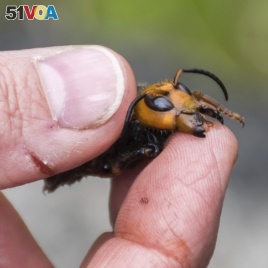05 May 2020
Hundreds of large Asian hornets, sometimes called "murder hornets," have been found in the American state of Washington. Agriculture officials said the insects present a threat to both humans and the beekeeping industry.
The insect can grow as large as 6.35 cm in length. Its sting can be deadly to some people. A native of East and Southeast Asia, the invasive insect is now starting to come out from winter hibernation.
"They're like something out of a monster cartoon with this huge yellow-orange face," said Susan Cobey. She raises and studies bees at Washington State University, or WSU.

In this April 23, 2020, photo provided by the Washington State Department of Agriculture, a researcher holds a dead Asian giant hornet in Blaine, Wash. The world's largest hornet, a 2-inch long killer with an appetite for honey bees, has been found in Washington state and entomologists are making plans to wipe it out. Dubbed the "Murder Hornet" by some, the Asian giant hornet has a sting that could be fatal to some humans. It is just now starting to emerge from hibernation. (Karla Salp/Washington State Department of Agriculture via AP)
The university said it is not known how or where the hornets arrived in North America. They likely arrived on a ship docking at one of Washington's ports. Transporting the insects on purpose would violate U.S. law.
The hornet was first seen in the U.S. last December when state officials confirmed two reports near Blaine, Washington. Two likely, but unconfirmed, reports also came from Custer, Washington, south of Blaine.
The hornets normally live in the forests and low mountains of Asia and feed on large insects, including wasps and bees. Its life cycle begins in April, when queens come out of hibernation and look for underground places to build their nests. Hornets are most destructive in the late summer and early fall. They attack honey bee hives, killing adult bees and eating their young.
Farmers depend on honey bees to pollinate many important northwest crops such as apples, blueberries and cherries. With the threat from large hornets, beekeepers may be less likely "to bring their hives here," said Island County Extension scientist Tim Lawrence.
Todd Murray is an insect and invasive species specialist with WSU. He said now is the time to deal with the hornets. "We need to teach people how to recognize and identify this hornet while populations are small, so that we can eradicate it while we still have a chance,″ Murray said.
Sven-Erik Spichiger is with the Washington state Agriculture Department. He warned people against trying to destroy the hornet's nests and urged them to contact officials.
Spichiger said hornets do not generally target people but they can attack when threatened. He added, "most people can survive one or two stings" but some might not survive several stings from the large insect.
I'm John Russell.
John Russell adapted this story based on reports from Reuters and the Associated Press. Hai Do was the editor.
_____________________________________________________________
Words in This Story
sting -- n. an injury caused when an insect or animal stings you
invasive – adj. tending to spread
hibernation – n. From hibernate: to spend the winter sleeping or resting
monster -- n. a strange or horrible imaginary creature
cartoon -- n. a film or television show made by photographing a series of drawings : an animated film or television show
dock -- v. to bring a ship or boat into a dock
life cycle – n. the series of stages through which a living thing passes from the beginning of its life until its death
pollination – n. botany : to move pollen from one flower to another
hive -- n. a nest for bees
eradicate – v. to remove (something) completely : to eliminate or destroy (something harmful)